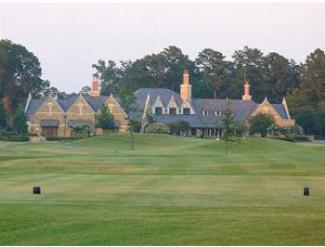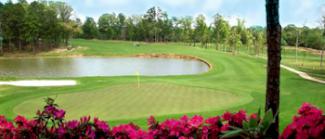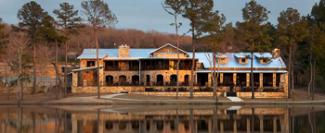Featured Golf News
Superb Courses in Tyler's Suburbs Lure Golfers from Afar
The city of Tyler has been one of northeast Texas's most attractive metropolitan areas almost from the time it was founded and named after John Tyler, the 10th president of the United States, in 1846.

The 15th Green at
The Dogwood course at Garden Valley
Yet, in a city with a population of about 100,000, sometimes golfers just need to get away from it all, even if it's only a short drive into the nearby countryside. One of the great things about living in or visiting Tyler is that there are a pair of outstanding courses just a short conversation away, and that both tracks are considered among the best tests of golf in the area.
It's not unusual that players from the bigger cities (such as Dallas, about 90 miles west of Tyler) and Shreveport (maybe an hour and a half to the east) head to Tyler and its surroundings for a round or two.
During a trip to Tyler last spring, I was able to play five of the area's courses - including two (the Dogwood Course at Garden Valley Golf Resort in Lindale and the Challenge Course at Eagle's Bluff in Bullard) that are outside the city proper. Golf in this neck of the Lone Star State is worth the effort thanks to the quality of the area's courses and the hospitality of the people I met in the area.
For this report, we will focus on the pair of courses listed above. See my previous story on the three courses within the Tyler city limits at www.cybergolf.com/golf_news/rosy_trio_make_the_grade_in_golfrich_tyler.

Azaleas in Bloom on the Dogwood Course
at Garden Valley
Garden Valley has High Aspirations
Situated at the gateway to the famous Piney Woods and the outdoor wonders of East Texas about 25 minutes northwest of downtown Tyler, the Dogwood Course at Garden Valley Golf Resort has been called the "Augusta National of Texas" by several magazines.
While that description is mighty high, the John Sanford-designed course does have a certain Augusta-like countenance because of its abundance of blooming azaleas and dogwoods, the 100-foot-tall pine trees, and rolling landscape.
Sanford's Jupiter, Fla.-based firm has built more than 65 courses around the globe and his team found a wonderful site in the Piney Woods. Dogwood's routing winds past and across two large lakes and through several groves of thick pines.
The Dogwood plays to a par of 72 and stretches 6,840 yards from the back set of three tees (the course was expanded by about 100 yards since it opened in 1992), and has been consistently rated as one of the top layouts in East Texas. It features Champion Bermuda greens, a change of turf from when it first opened.
The opening nine brings water into play on five holes - including both the par-3s and the two par-5s, and is routed across the more open area of the property. The round starts out with a 370-yard par-4 that bears a lone bunker left of the landing area and another right of the green. The 190-yard par-3 second involves a tee shot over water, and the 452-yard third is tough, especially from the tips, which make the severe dogleg-left fairway play 130 yards farther than the second set of tees.
The 456-yard par-4 eighth is the longest two-shotter on the course and it's pinched at the landing area by three bunkers. You'll need the carry water twice on the 595-yard par-5 ninth and another pond front-right of a sloping green.
Nothing at Dogwood course's outward side prepares you for what's next on the fabulous home half, where each hole is very different. Some holes require precise drives, others ask for considerable care on the second or third shots to hit the green. And there's a little of everything that makes golf fun and challenging: strategic shot-making, sharp doglegs, blind shots, elevation changes, narrow tree-lined fairways, berms, water hazards and bunkers, all with a scenic backdrop.

Garden Valley Golf Resort
As an example, No. 11 is a downhill dogleg-right par-4 of 407 yards with trees, water and a bunker left of the optimal landing area. The 212-yard 12th plays all over water to a putting surface guarded left by three bunkers, and the 388-yard par-4 13th begins with a fun downhill tee shot that has to be precise and a second to a small green pinched by water left.
Both 16 and 17 (at 362 and 393 yards, respectively) are tight par-4s that curl through the woods as the course heads back toward the clubhouse. The 519-yard par-5 closer is a stirring climax to Garden Valley, with Jackson Lake all along the right, trees left, and a smallish, amphitheater-like green awaiting your final touchdown.
The Dallas Morning News recognized the Dogwood course at Garden Valley in 2011 as one of the "Top 100 Courses You Can Play" in the state of Texas for the second consecutive year, while Links magazine featured the course in its 2011 "Best of Texas" issue.
Ultimately, the entire layout will have you focusing on the scenery as much as the shot. The beauty of Sanford's Dogwood track is not how much he did, but how well he fit the course into the existing landscape. A round here, especially in the spring with the flowers blooming, is truly a treat.
For additional information, visit http://gardenvalleytx.com/.

The 10th Hole & Clubhouse at Eagle's Bluff
Demanding Shot-making the Appeal at Eagle's Bluff
Leaving Tyler from its southwest corner, one finds the town of Bullard, which sits quietly on a watery arm of Lake Palestine, a 26,000-acre reservoir and sportsman's paradise. The cliffs above the lake are the site of one of the area's top gated residential communities - Eagle's Bluff, and its Challenge course is the neighborhood's centerpiece.
The Challenge was the last track designed and built by noted Texas golf course designer Carlton Gipson. The late architect considered Eagle's Bluff to be the greatest work of his 38-year career.
Surrounded by century-old dogwood, oak and pine, the course is enhanced by the region's world-famous azaleas. With water hazards on nine of the 18 holes and Tiff-Eagle grass greens averaging 8,500 square feet in size, Eagle's Bluff places a premium on strategy and precision.

No. 8 Green at Eagle's Bluff GC
Gipson was able to preserve the natural East Texas forest setting at Eagle's Bluff and, in the process, fashion a course that is chock-full of twists and turns. The putting surfaces can be daunting because of their slopes, undulations and multiple tiers. The greens here, however, run true and fast, and if the approaches to them end up above the pin, be very careful.
Eagle's Bluff opened in 1999. It plays to a par of 71 and is carded at 6,977 yards from its back set of four tees; the tips carry a whopping rating of 74.2 and a Slope of 140. It is formidable; the course has been rated as the sixth-most difficult in Texas by The Dallas Morning News.
It's important to pick the right set of tees or you'll be humbled by the Challenge at Eagle's Bluff. Length, plus water on 13 holes, 46 bunkers of all shapes and sizes, downhill and uphill shots, doglegs, risk-reward opportunities and rugged green complexes test your game from the tee to the cup.
Both the front and back sides here feature an island green; the course's signature hole is the 210-yard, downhill par-3 15th, which is engirded by water. In fact, all four one-shotters at Eagle's Bluff can be daunting as each extends 194 yards or more.
The first real test comes at the 433-yard par-4 fourth, where the approach is played over a pond to an elevated green backed by three bunkers. The par-3 fifth plays at 220 yards and discourages run-up shots as two large sand hazards are on either side of a narrow sliver of an opening at the green front.
Eagle's Bluff's 543-yard par-5 sixth is unique as the drive demands a decision to play over one arm of a creek but in front of another. Its elevated putting surface tilts back to front and is lined on both sides by sand.
The farther the shot travels off the tee the narrower the fairway gets at the 401-yard par-4 eighth. No matter how you attack this hole, the approach must factor in a pond on the starboard side. The 521-yard par-5 12th asks golfers to find the landing area off the tee between a lake on the left and a bunker right before taking a go at its raised and well-protected green.
Your round at Eagle's Bluff ends with two of the most difficult holes on the course. Playing 452 yards, the par-4 17th required both power and finesse to reach the putting surface and a nimble touch to negotiate one of the trickiest greens on the property.
No. 18, a 434-yard par-4, almost demands a shot of no more than 270 yards off the tee. It then makes one hit a long approach over a pond that lines the left side to a green that buttonhooks back toward the water after passing a huge bunker.
Eagle's Bluff, located just 15 minutes south of Tyler and about an hour and a half from Dallas, is widely considered the finest lakefront community in East Texas. The practice facilities boast an eight-acre driving range and a 10,000-square-foot putting green, with an additional chipping green surrounded by grass and sand bunkers.
For three years in a row, Golfweek has recognized Eagle's Bluff on Lake Palestine as a "Course of Distinction" among its listing of "America's Best Residential Golf Courses." For more information, visit http://eaglesbluff.com/index.php.
Both Eagle's Bluff and the Garden Valley Golf Resort are operated by The Challenge Golf Group, which is based in Marshall, Texas, and has a portfolio that includes 10 golf communities in Texas, South Carolina and North Carolina.

Tyler-area Lakefront Dining at Lago del Pino
Tyler off the Course
Our accommodations while in Tyler were at the excellent Courtyard by Marriott on Broadway Avenue south of the city's main loop; the hotel was spotless and convenient and the folks there are super service-focused.
We were also able to try a few of the area's best restaurants, including Lago del Pino just west of the city on the edge of Lost Pine Lake, and Fat Catz Louisiana Kitchen a block from the city's main loop.
Steve Habel is a freelance writer contributing Cybergolf news stories, features, equipment and book reviews and personality profiles from his base in Central Texas. He also works as a contributing editor for Horns Illustrated magazine, a publication focusing on University of Texas sports, and is a contributing writer for Golfers' Guide and Golf Oklahoma magazine, Texas Links magazines and Golfers Guide. Habel's main blog (www.shotoverthegreen.blogspot.com) features news on golf and the Longhorns, and another (www.checkinginandplayingthrough.blogspot.com) chronicles his many travels, including playing more than 600 golf courses since 2008. Habel is a member of the Golf Writers Association of America and the Texas Golf Writers Association.
Story Options
 |
Print this Story |
